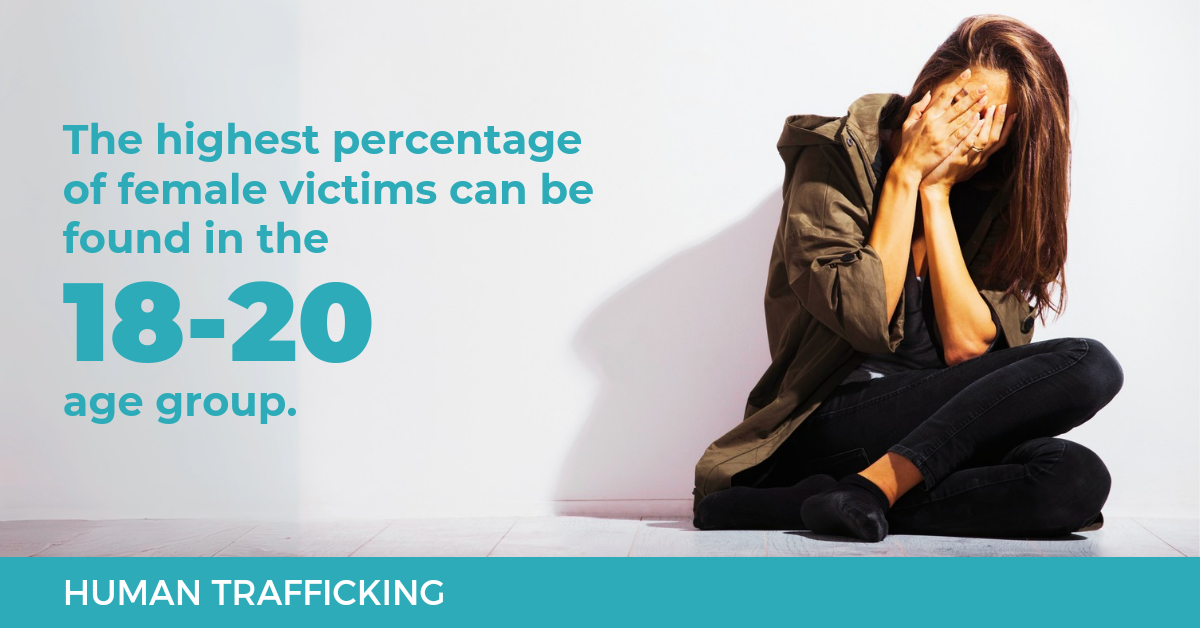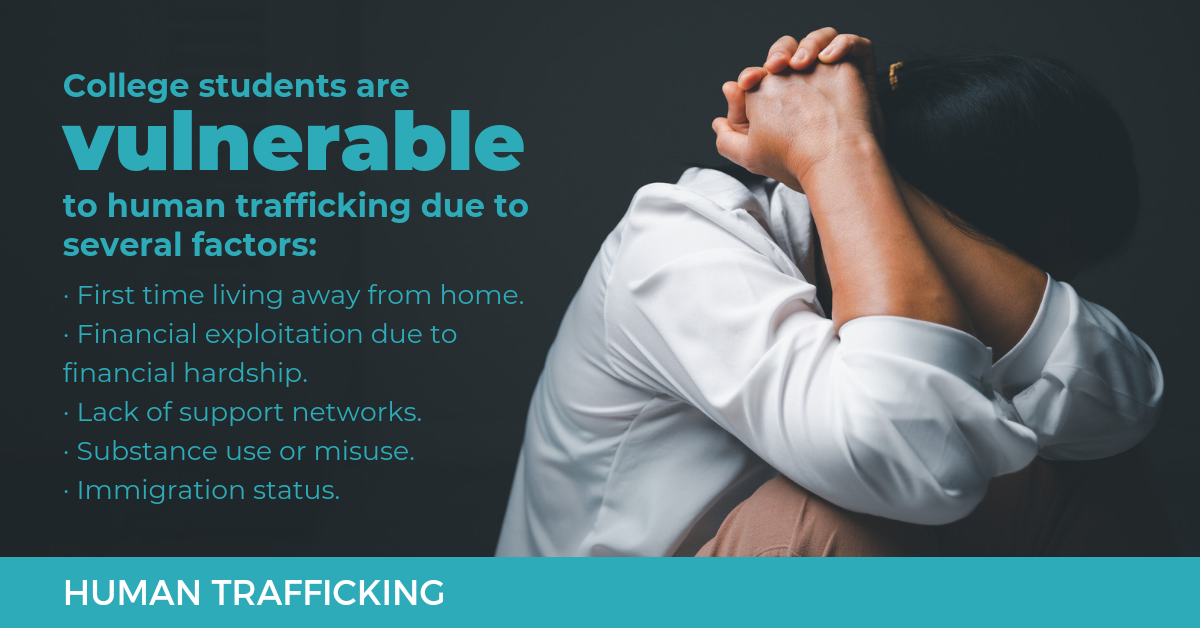Judy Daniels, MSN, RN, AGPCNP-BC | Updated/Verified: September 9, 2024
A severe problem hiding in plain sight, human trafficking affects millions of people around the world – including many in our very own communities. It’s estimated that around 50 million people were victims of human trafficking in 2021 alone, with more than 10,000 situations reported to the United States Human Trafficking Hotline in this same year. The numbers, sadly, continue to rise.
Human trafficking is the illegal act of forcing people to work or perform other actions against their will. In some cases, it even involves forced marriage. It’s modern slavery, affecting people of all ages, nationalities, sexes, and backgrounds. Why should you care? Because human trafficking doesn’t just happen “somewhere else.” It can happen in our cities and our neighborhoods. Statistics show that many victims come into contact with healthcare professionals or are in school settings at some point during their situation, putting educators and healthcare workers in a unique position to help. Multiple studies have found that up to 88% of victims of human trafficking come into contact with the healthcare system while being trafficked. Women’s health nurse practitioners can help prevent human trafficking by understanding how to identify risks and connect services accordingly.

By sharing this information, we hope to empower you with the vital knowledge to recognize the signs and how to lend a helping hand. Together, we can make our communities safer for everyone.
Healthcare Worker Resources
Improving Identification of Patients At Risk for Human Trafficking
The Children’s Hospital Association released a safety alert that includes the signs of young trafficking victims and how healthcare professionals can identify them.
Anti-Trafficking Resources for Healthcare
Use the multiple videos on this site to learn more about human trafficking as they tackle topics like how to support and help survivors and the signs of trafficking.
The American Hospital Association offers free digital toolkits in English and Spanish, tips on how to talk to victims and survivors, and other resources.
Available from the Office of Trafficking in Persons, this page looks at the type of healthcare victims seek or need and where medical professionals can go for help.
The Role of Healthcare Providers in Combating Human Trafficking During Disasters
Human trafficking commonly happens during disaster situations, and the ASRP offers infographics and other resources for providers who want to help.
Assessing Healthcare Provider Knowledge of Human Trafficking
The researchers behind this study sent surveys to healthcare professionals to test their knowledge about human trafficking and then compiled the results.
Human Trafficking: The Role of the Health Care Provider
Discover what you need to know about human trafficking as a healthcare professional and how you can support any victims you encounter in this piece.
Victims of Human Trafficking Going Undetected in Healthcare Settings
Two medical professionals worked on this article to help others understand why trafficking victims often go undetected and what medical workers can do.
Medical Education on Human Trafficking
The AMA Journal of Ethics published this article, which looks at current and past research to show why medical professionals need more training to address the issue.
Designed for healthcare professionals, this PDF helps you see some of the lessons learned by medical professionals based on their experiences with trafficking victims.
Prevention
20 Ways You Can Help Fight Human Trafficking
The 20 tips on this list are easy enough for anyone to do, and they include a hotline you can call if you believe someone is a victim and fundraising ideas.
Learn what human trafficking is, who is behind the issue, the red flags to watch for, and much more on this page from the Drug Enforcement Agency (DEA).
Ten Things You Can Do to Help Stop Human Trafficking
Learn who to call when you meet someone in need of help, learn how to take action in your community, and find other helpful tips to fight back against human trafficking.
Preventing Human Trafficking: Resources for Physicians
Doctors will find short descriptions of the various resources on this page, such as the AMA Code of Medical Ethics and AMA policies.
Preventing Human Trafficking Using Data-Driven, Community-Based Strategies
Community Psychology looks at the different ways to prevent human trafficking at the local, neighborhood, family, and societal levels.
6 Measures to Prevent Human Trafficking Within Your Organization
The six measures listed here are suitable for all organizations and include how to raise awareness in your community and when to use a helpline.
CTIP Student Guide to Preventing Human Trafficking
Though designed for students, this guide also includes information for parents who want to prevent and stop human trafficking in their areas.
Technology and Human Trafficking: Avoid the Trap!
The UN offers a range of tips on how you can prevent human trafficking online, such as using strong privacy settings and flagging any harmful content you see.
Prevention, Prosecution, and Protection – Human Trafficking
Also, this article from the UN looks at some of the modern and lesser-known types of human trafficking and the prevention, prosecution, and protection needed.
Use this website to learn practical tips you can use to prevent human trafficking in your area and what to do if you think you see some of the signs of trafficking.

Articles
Human Trafficking and the Healthcare Industry
Polaris found that more than 80% of human trafficking victims seek healthcare support and share information on what those workers can do to help them.
Recognizing and Responding to Human Trafficking in a Healthcare Context
Learn how to recognize trafficking victims in healthcare settings and how to assist them along with other useful tips in this article from a major national organization.
This study interviewed more than 40 healthcare workers in Houston to uncover the themes and challenges they faced in identifying victims in healthcare settings.
Human Trafficking: Review of Educational Resources for Health Professionals
The authors of this study reviewed the educational resources available to healthcare professionals to guide them in what they should and should not do.
Health Care and Human Trafficking: We are Seeing the Unseen
Published in 2016, this study involved more than 100 human trafficking victims to talk about their health needs and how often they sought medical attention.
Engaging Survivors of Human Trafficking: Complex Health Care Needs and Scarce Resources
Learn why human trafficking is a human rights violation in this piece, which also looks at the limited resources for healthcare professionals who work with victims.
Human Trafficking: The Role of the Health Care Provider
Learn more about the healthcare provider’s role in this piece and how you can help the victims you encounter on the job.
Multi-Level Prevention of Human Trafficking: The Role of Health Care Professionals
Discover how healthcare professionals can spot the signs of human trafficking among their patients and how to prevent trafficking in this article.
This article reviewed dozens of studies from 2010 that looked at the trafficking of children before writing the results that it found in a simple format.
Human Trafficking: A Health Care Perspective
Read through this article to learn about the healthcare needs of trafficking victims and what medical professionals can do in various situations.
Educating Health Care Professionals on Human Trafficking
Twenty emergency departments (EDs) underwent extensive training to educate them on human trafficking, and the results are shown in this study.
Training US Health Care Professionals on Human Trafficking: Where Do We Go From Here?
Read the results of this study to learn about the lack of education medical professionals receive about human trafficking and the type of training they’ll need in the future.
Organizations
The Polaris Project gives hope to trafficking victims and survivors through information about human trafficking along with research into the subject and public awareness campaigns.
Operation Underground Railroad
Taking a page from the Underground Railroad, the OUR fights to end human trafficking and sexual exploitation through programs that helped save more than 7,000 people.
Freedom Network USA is a significant coalition comprised of legal professionals and others who offer training and run advocacy programs to end human trafficking.
National Human Trafficking Hotline
This hotline has people ready to answer the phones 24/7 to help victims and assist those who believe they saw human trafficking in their areas.
Located in the Midwest and Florida, this organization offers programs that include raising awareness of the topic and teaching prevention methods to others.
The Exodus Road shares real stories from human trafficking survivors and helps you learn about the organization’s work in the US and other nations.
Health, Education, Advocacy, Linkage
Better known as HEAL, this nonprofit offers counseling for survivors and victims, resources like a digital toolkit, and speakers who will come to your community.
Center for Prevention of Abuse
The Center for Prevention of Abuse believes in stopping all forms of abuse through free resources for those who want to help others and those who need immediate help.
Administration for Children & Families Office on Trafficking in Persons
This organization wants to inform and educate the general public on human trafficking, which it does through an academy and special programs for survivors.
Alliance to End Human Trafficking
The Alliance to End Human Trafficking offers a ton of resources and services that include some, like counseling and educational programs for survivors.
Collaborative to End Human Trafficking
Find free online resources from this organization and programs for survivors and others that provide them with free training and education.
United Against Human Trafficking
Join United Against Human Trafficking to learn about their direct programs, as well as those designed to help young people avoid human trafficking situations.
Books
Human Trafficking Around the World: Hidden in Plain Sight
Stephanie Hepburn and Rita J. Simon collaborated on Human Trafficking Around the World, which talks about organ trafficking, sex tourism, and other trafficking methods.
Girls Like Us: Fighting for a World Where Girls Are Not for Sale
Rachel Lloyd wrote her memoir to share her experiences as a trafficking victim in the hopes of getting others to realize the severity of the problem and how they can help.
In Disposable People, author Kevin Bales discusses the issue of new slavery to show readers that it’s a form of human trafficking that still exists today.
Patricia McCormick wrote the award-winning book Sold, which uses vignettes to describe the horrors a young girl went through as a victim of trafficking.
Human Trafficking: The Complexities of Exploitation
The editors behind this book explain the basics of human trafficking and exploitation as they discuss how and why the issue exists despite legislation around the world.
Stolen: The True Story of a Sex Trafficking Survivor
Katariina Rosenblatt is a victim of sex trafficking who shares her story in this memoir to help other young girls avoid following her path.
In Our Backyard: Human Trafficking in America and What We Can Do to Stop It
Nita Belles met with survivors of human trafficking and shared their stories in this book, which attempts to find solutions to the problem.
Sex Trafficking in the United States: Theory, Research, Policy, and Practice
Andrea J. Nichols focuses on why some people become victims of sex trafficking in the US and the challenges they face when they try to escape.
The White Umbrella: Walking with Survivors of Sex Trafficking
The author of this book describes the white umbrella as the help given to victims and explains how anyone can help someone exploited by another.
Vulnerable: Rethinking Human Trafficking
In this book, Raleigh Sadler explores the common victims of human trafficking and encourages others to take a stand and understand their role in the problem.

College Students
Human Trafficking Response Guide for Campus Law Enforcement and Public Safety Officials
Available as a PDF, this guide talks about how exploiters find their victims and what they do, as well as how those in security positions on college campuses can prevent trafficking.
Human Trafficking on College Campuses: What it Looks Like and Resources for Police, Students
Campus Safety worked with Maraya Lasinsky to go over what human trafficking looks like and how both police and students can find out more.
Human Trafficking – Higher Education
In this piece, you’ll find out why human trafficking is so common on some campuses and what resources are available from major organizations.
Campus Human Trafficking Prevention Toolkit
Released by an organization in North Carolina, this toolkit offers practical information, such as the myths behind human trafficking and the trades where it’s the most common.
Student Shares Sex Trafficking Story to Raise Awareness, Help Students
Read about Sarah here, a victim of sex trafficking who made her way out and spoke to students at the University of South Carolina about her experiences.
Do College Students Have a Lack of Awareness Around Human Trafficking?
In her thesis, Tessa Cavender discusses the lack of awareness college students have about human trafficking and what it might mean for their futures.
From Blue Campaign, this toolkit supplies college and university students with tips on how they can raise awareness of trafficking and protect other students.
Helping Your College Student Recognize Human Traffickers
Mind Site News created a simple article to help parents talk with their kids about human trafficking on college campuses and how they can stay safe.
Yes, College Students Can Be Human Trafficking Victims
Karley Gordon describes how college students become trafficking victims and addresses the red flags that should make them think twice when meeting new people.
College Days: America’s College Students Face Threat of Sex Trafficking
A member of an anti-trafficking organization spoke with the author of this piece to talk about how traffickers find victims on college campuses.
Videos
The U.S. Department of Homeland Security hosts this video, which goes over the basics of human trafficking and its effects on the world at large.
Learn about the signs of human trafficking and those you might miss in this video from the Peel Regional Police, which is just over three minutes long.
Unchained: The Scourge of Human Trafficking
David Strathairn narrates this 26-minute video that looks at the dangers of human trafficking and shares stories from survivors who escaped.
Human Trafficking Awareness at Airports
In just five minutes, this video shows you how to spot the signs of human trafficking when you travel for work or fun and pass through airports.
Human Trafficking Truck Stop Animated Video
Another video from Homeland Security, this one shows how human trafficking can occur at a truck stop and what viewers should do next.
Human Trafficking Survivor Stories
Amanda and Carrie are just a few of the human trafficking survivors who shared their stories in this video to help others escape similar situations.
Faces of Human Trafficking: An Introduction
The Office for Victims of Crime wants to help you put a face to the name of trafficking survivors, which is why it posted this video where survivors talk about their experiences.
FBI Seattle Discusses the Myths of Human Trafficking
You can watch this video online and download a copy to hear members of the Seattle FBI go over some of the common myths associated with human trafficking.
Podcasts
In this podcast, WYSO Public Media discusses the work that advocates do to raise awareness of human trafficking using their limited resources.
Dr. Sandra Morgan hosts the Ending Human Trafficking podcast, which has more than 300 episodes dedicated to topics like how to keep kids safe online.
Mobilizing the Fight Against Human Trafficking
The human trafficking problem in Houston and its possible solutions, along with the connection between trafficking and foster care, are issues addressed in this podcast.
Insight Into Human Trafficking
This podcast from the University of Notre Dame offers insights from a professor in the university’s business department on why human trafficking exists.
The Global Center for Women and Justice launched Ending Human Trafficking to cover all aspects of human trafficking through discussions with leading professionals.
Human Trafficking – True Crime
Listen to stories of genuine human trafficking victims who share their stories with this podcast to discover the traumatic experiences they had.
Trafficked: The Trap: Part One
Many people have a hard time understanding how people become victims of human trafficking, but this podcast goes over the traps they set to attract them.
With more than 300 episodes, this podcast covers dozens of topics, such as how government agencies fight back and how medical professionals should respond.
Hearing the Voices of Human Trafficking Victims
Hear directly from the victims and survivors of human trafficking as they talk about their experiences and share their stories with this podcast.
Unseen: The Traffickd Truth Podcast
Unseen is a podcast dedicated to sexual trafficking that features stories from survivors and tells you about cases the popular media didn’t cover.
Fair Use Statement: Please share our content for editorial or discussion purposes. Please link back to this page and give proper credit to NursePractitionerOnline.com.


